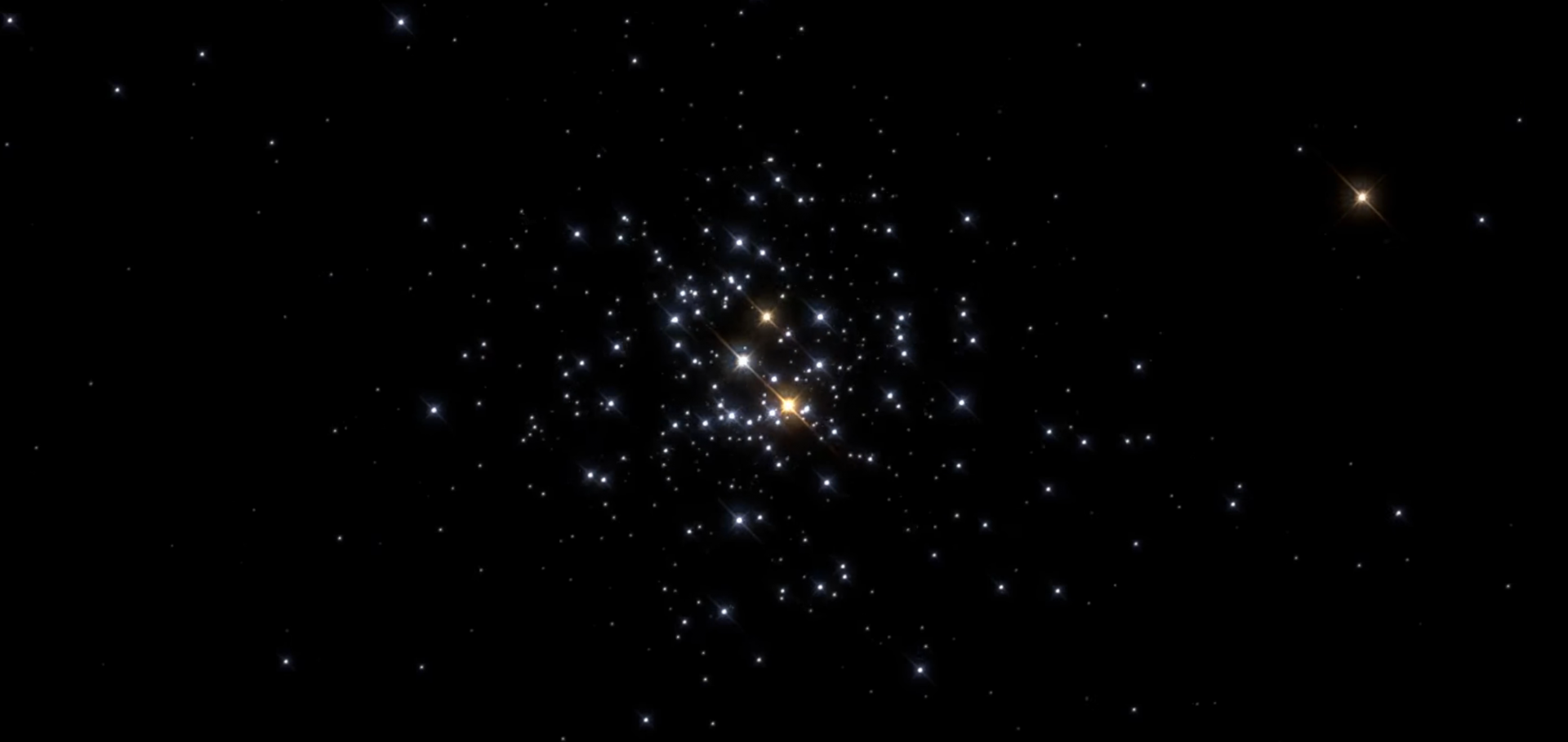Relativistic Pythagorean three-body problem
Physical Review D American Physical Society 104:8 (2021) 83020
Abstract:
We study the influence of relativity on the chaotic properties and dynamical outcomes of an unstable triple system; the Pythagorean three-body problem. To this end, we extend the brutus N-body code to include post-Newtonian pairwise terms up to 2.5 order, and the first order Taylor expansion to the Einstein-Infeld-Hoffmann equations of motion. The degree to which our system is relativistic depends on the scaling of the total mass (the unit size was 1 parsec). Using the brutus method of convergence, we test for time-reversibility in the conservative regime, and demonstrate that we are able to obtain definitive solutions to the relativistic three-body problem. It is also confirmed that the minimal required numerical accuracy for a successful time-reversibility test correlates with the amplification factor of an initial perturbation, as was found previously for the Newtonian case. When we take into account dissipative effects through gravitational wave emission, we find that the duration of the resonance, and the amount of exponential growth of small perturbations depend on the mass scaling. For a unit mass , the system behavior is indistinguishable from Newton’s equations of motion, and the resonance always ends in a binary and one escaping body. For a mass scaling up to , relativity gradually becomes more prominent, but the majority of the systems still dissolve in a single body and an isolated binary. The first mergers start to appear for a mass of , and between and all systems end prematurely in a merger. These mergers are preceded by a gravitational wave driven in-spiral. For a mass scaling , all systems result in a gravitational wave merger upon the first close encounter. Relativistic three-body encounters thus provide an efficient pathway for resolving the final parsec problem. The onset of mergers at the characteristic mass scale of potentially leaves an imprint in the mass function of supermassive black holes.Radio astronomy and Space science in Azores: Enhancing the Atlantic VLBI infrastructure cluster
Advances in Space Research Elsevier 68:7 (2021) 3064-3078
Abstract:
Radio astronomy and Space Infrastructures in the Azores have a great scientific and industrial interest because they benefit from a unique geographical location in the middle of the North Atlantic allowing a vast improvement in the sky coverage. This fact obviously has a very high added value for: i) the establishment of space tracking and communications networks for the emergent global small satellite fleets ii) it is invaluable to connect the radio astronomy infrastructure networks in Africa, Europe and America continents using Very Large Baseline Interferometry (VLBI) techniques, iii) it allows excellent potential for monitoring space debris and Near Earth Objects (NEOs). There is in S. Miguel island a 32-metre SATCOM antenna that could be integrated in advanced VLBI networks and be capable of additional Deep Space Network ground support. This paper explores the space science opportunities offered by the upgrade of the S. Miguel 32-metre SATCOM antenna into a world-class infrastructure for radio astronomy and space exploration: it would enable a Deep Space Network mode and would constitute a key space facility for data production, promoting local digital infrastructure investments and the testing of cutting-edge information technologies. Its Atlantic location also enables improvements in angular resolution, provides many baselines in East–West and North–South directions connecting the emergent VLBI stations in America to Europe and Africa VLBI arrays therefore contributing for greater array imaging capabilities especially for sources or well studied fields close to or below the celestial equator, where ESO facilities, ALMA, SKA and its precursors do or will operate and observe in the coming decades.Stellar collisions in flattened and rotating Population III star clusters
Astronomy and Astrophysics EDP Sciences 649:2021 (2021) A160
Abstract:
Fragmentation often occurs in disk-like structures, both in the early Universe and in the context of present-day star formation. Supermassive black holes (SMBHs) are astrophysical objects whose origin is not well understood; they weigh millions of solar masses and reside in the centers of galaxies. An important formation scenario for SMBHs is based on collisions and mergers of stars in a massive cluster with a high stellar density, in which the most massive star moves to the center of the cluster due to dynamical friction. This increases the rate of collisions and mergers since massive stars have larger collisional cross sections. This can lead to a runaway growth of a very massive star which may collapse to become an intermediate-mass black hole. Here we investigate the dynamical evolution of Miyamoto-Nagai models that allow us to describe dense stellar clusters, including flattening and different degrees of rotation. We find that the collisions in these clusters depend mostly on the number of stars and the initial stellar radii for a given radial size of the cluster. By comparison, rotation seems to affect the collision rate by at most 20%. For flatness, we compared spherical models with systems that have a scale height of about 10% of their radial extent, in this case finding a change in the collision rate of less than 25%. Overall, we conclude that the parameters only have a minor effect on the number of collisions. Our results also suggest that rotation helps to retain more stars in the system, reducing the number of escapers by a factor of 2-3 depending on the model and the specific realization. After two million years, a typical lifetime of a very massive star, we find that about 630 collisions occur in a typical models with N = 104, R = 100 Rpdbl and a half-mass radius of 0.1 pc, leading to a mass of about 6.3 × 103 Mpdbl for the most massive object. We note that our simulations do not include mass loss during mergers or due to stellar winds. On the other hand, the growth of the most massive object may subsequently continue, depending on the lifetime of the most massive object.Effect of mass-loss due to stellar winds on the formation of supermassive black hole seeds in dense nuclear star clusters
Monthly Notices of the Royal Astronomical Society Oxford University Press 505:2 (2021) 2186-2194
Abstract:
The observations of high-redshifts quasars at z ≳ 6 have revealed that supermassive black holes (SMBHs) of mass ∼109M⊙∼109M⊙ were already in place within the first ∼Gyr after the big bang. Supermassive stars (SMSs) with masses 103−5M⊙103−5M⊙ are potential seeds for these observed SMBHs. A possible formation channel of these SMSs is the interplay of gas accretion and runaway stellar collisions inside dense nuclear star clusters (NSCs). However, mass-loss due to stellar winds could be an important limitation for the formation of the SMSs and affect the final mass. In this paper, we study the effect of mass-loss driven by stellar winds on the formation and evolution of SMSs in dense NSCs using idealized N-body simulations. Considering different accretion scenarios, we have studied the effect of the mass-loss rates over a wide range of metallicities Z* = [.001–1]Z⊙ and Eddington factors fEdd=L∗/LEdd=0.5,0.7,and0.9fEdd=L∗/LEdd=0.5,0.7,and0.9. For a high accretion rate of 10−4M⊙yr−110−4M⊙yr−1, SMSs with masses ≳103M⊙yr−1≳103M⊙yr−1 could be formed even in a high metallicity environment. For a lower accretion rate of 10−5M⊙yr−110−5M⊙yr−1, SMSs of masses ∼103−4M⊙∼103−4M⊙ can be formed for all adopted values of Z* and fEdd, except for Z* = Z⊙ and fEdd = 0.7 or 0.9. For Eddington accretion, SMSs of masses ∼103M⊙∼103M⊙ can be formed in low metallicity environments with Z* ≲ 0.01 Z⊙. The most massive SMSs of masses ∼105M⊙∼105M⊙ can be formed for Bondi–Hoyle accretion in environments with Z* ≲ 0.5 Z⊙. An intermediate regime is likely to exist where the mass-loss from the winds might no longer be relevant, while the kinetic energy deposition from the wind could still inhibit the formation of a very massive object.Formation of supermassive black hole seeds in nuclear star clusters via gas accretion and runaway collisions
Monthly Notices of the Royal Astronomical Society Oxford University Press 503:1 (2021) 1051-1069


